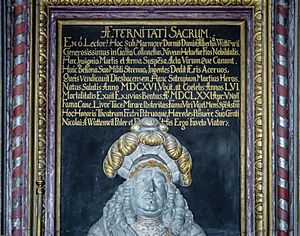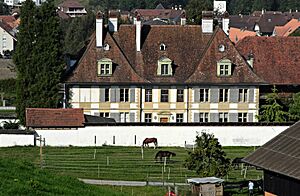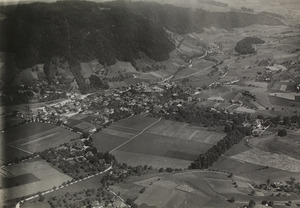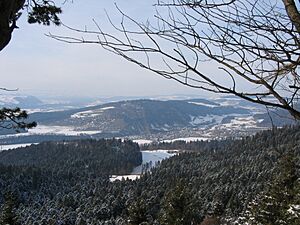Oberdiessbach facts for kids
Quick facts for kids
Oberdiessbach
|
||
|---|---|---|
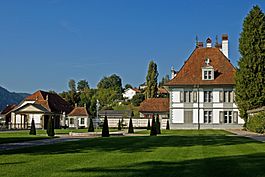 |
||
|
||
| Country | Switzerland | |
| Canton | Bern | |
| District | Bern-Mittelland | |
| Area | ||
| • Total | 16.47 km2 (6.36 sq mi) | |
| Elevation | 605 m (1,985 ft) | |
| Population
(Dec 2020 )
|
||
| • Total | 3,552 | |
| • Density | 215.66/km2 (558.57/sq mi) | |
| Postal code |
3672
|
|
| Surrounded by | Bleiken bei Oberdiessbach, Freimettigen, Häutligen, Herbligen, Linden, Wichtrach | |
| Twin towns | Féchy (Switzerland), Kardašova Řečice (Czech Republic) | |
Oberdiessbach is a town, also known as a municipality, in Switzerland. It is located in the canton of Bern, within the Bern-Mittelland administrative district.
On January 1, 2010, the nearby town of Aeschlen joined Oberdiessbach. Then, on January 1, 2014, Bleiken bei Oberdiessbach also merged with Oberdiessbach. This made Oberdiessbach a larger municipality.
Contents
History of Oberdiessbach
Oberdiessbach was first mentioned in official records in 1218. At that time, it was called Tiecebac. Later, until 1870, it was known as Diessbach.
In the Late Middle Ages, Diessbach was the main town of a territory called a Herrschaft. This was an area ruled by a lord. In 1218, Hartmann IV of Kyburg took control of Diessbach. The village and its castle, Diessenberg, stayed with the Kyburg family for a while. They then gave it to the Senn von Münsingen family, who were knights serving a powerful lord.
In 1331, the city of Bern attacked and destroyed the castle. This happened as Bern was expanding its power in the region. The Senn family still ruled the valley for over 40 years after the castle was destroyed.
Starting in 1378, the Herrschaft of Diessbach was owned by several rich families. In 1647, the von Wattenwyl family bought Diessbach. The area's main court was independent until 1471, when Bern made it recognize Bern's authority.
A new castle was built in the valley in 1560 to govern the area. This castle was replaced in 1668 by an even newer one, known as the Oberdiessbach Castle. Albrecht von Wattenwyl oversaw its construction. The von Wattenwyl family continued to live in the town for many centuries. Around 1728, they also built a country estate called Diessenhof.
The town's church was first mentioned in 1266. The building you see today was built in 1498. In the late 1600s, the von Wattenwyl family added their own private chapel inside the church.
Because it was the center of a Herrschaft, Oberdiessbach grew into an important regional town early on. The first school in the area opened in the 1600s. A secondary school followed in 1856, and a trade school in 1895. A hospital opened in 1880, which later became the district hospital.
By the 1700s, Oberdiessbach had many businesses. There were mills, forges for horseshoes and nails, a sawmill, a tannery (for leather), and a saddlery. Leaders tried to start a silk factory and a glass factory, but they didn't succeed. The town began to industrialize after 1899. This was when the Burgdorf-Thun Railway built a train station there. The population slowly grew, and new houses were built in the 1970s. By 2005, more than half of the people working in Oberdiessbach had jobs in manufacturing.
Bleiken bei Oberdiessbach Joins Oberdiessbach
Bleiken bei Oberdiessbach was first mentioned in 1337 as Bleikon. In 1473, it was simply called "villages".
This village was settled later than many other nearby places. In 1880, a medical spa resort was built there. The spa eventually closed, and the building is now an apartment complex. Even after the spa, the village remained quite isolated. In 1908, a Postauto (bus) route connected Bleiken with Oberdiessbach. Today, many people living in Bleiken travel to Oberdiessbach for work. Most jobs in Bleiken are in farming or small businesses.
Geography of Oberdiessbach
Oberdiessbach covers an area of about 8.2 square kilometers (3.2 square miles). A large part of this land, about 51%, is used for farming. Forests cover about 39% of the area.
About 10% of the land is developed with buildings or roads. A very small amount is rivers or lakes. The rest is unproductive land.
The town is located in the Kiesental (Kiesen Valley). It sits between the hills of Kurzenberg, Falkenfluh, and Hube. The municipality includes the main village of Oberdiessbach and the smaller communities of Glasholz and Hauben. As mentioned, Aeschlen joined in 2010, and Bleiken bei Oberdiessbach in 2014.
Coat of Arms
The blazon (description) of Oberdiessbach's coat of arms is: "Sable a Bendlet dancety Or between two Lions passant of the same langued and viriled Gules."
In simpler terms, the coat of arms is black. It has a zig-zag golden stripe across it. On either side of the stripe are two golden lions.
Population and People
As of December 2011, Oberdiessbach had a population of 3,101 people. About 5.7% of the people living there are foreign nationals. Over the past decade, the population has stayed mostly the same.
Most people in Oberdiessbach (about 95%) speak German as their main language. Serbo-Croatian is the second most common language, followed by French.
In 2008, the population was split evenly between men and women. About 27% of the people living in Oberdiessbach in 2000 were born there. Many others were born in the same canton (state) of Bern.
In 2011, children and teenagers (ages 0-19) made up about 24% of the population. Adults (20-64 years old) made up almost 60%, and seniors (over 64) made up about 16%.
Historic Population
The chart below shows how the population of Oberdiessbach and Bleiken bei Oberdiessbach has changed over time.

Important Buildings and Sites
Several places in Oberdiessbach are considered very important national heritage sites. These include:
- The Chapel of the von Wattenwyl family.
- The country estate called Diessenhof.
- Oberdiessbach Castle.
- Since the 2014 merger, the Statthalterhof in Bleiken.
The entire old village area of Oberdiessbach is also part of the Inventory of Swiss Heritage Sites. This means it's a special place that needs to be protected for its historical value.
Economy and Jobs
In 2011, Oberdiessbach had a very low unemployment rate of less than 1%. This means almost everyone who wanted a job had one.
In 2008, there were 1,738 people working in the town.
- About 151 people worked in the primary sector, which includes farming and forestry.
- About 848 people worked in the secondary sector, mainly in manufacturing and construction.
- About 739 people worked in the tertiary sector, which includes services like sales, transportation, hotels, healthcare, and education.
Many people who live in Oberdiessbach also work there. In 2000, about 1,000 workers came into the town for their jobs, while about 900 residents traveled outside the town for work. This means Oberdiessbach brings in more workers than it sends out.
About 18% of the working population used public transportation to get to work. Almost half (47.6%) used a private car.
Religion
Based on a 2000 survey, most people in Oberdiessbach (about 76%) belonged to the Swiss Reformed Church. About 6% were Roman Catholic.
A smaller number of people belonged to other Christian churches. There were also people who were Islamic, Buddhist, or Hindu. About 5.5% of the population did not belong to any church or religion.
Education
In Oberdiessbach, about 39% of the population has finished upper secondary education. This is like high school. About 12% have gone on to higher education, such as university or a specialized college.
The school system in the Canton of Bern starts with one year of non-required Kindergarten. After that, students attend six years of Primary school. Then, they go to three years of lower Secondary school. In secondary school, students are grouped based on their abilities. After lower secondary, students can choose to continue their education or start an apprenticeship (on-the-job training).
During the 2010-2011 school year, 469 students attended schools in Oberdiessbach.
- There were 34 students in kindergarten.
- There were 232 students in primary school.
- There were 203 students in lower secondary school.
Oberdiessbach also has a library called Mediothek Oberdiessbach. In 2008, the library had over 9,500 books and other media. It loaned out more than 25,000 items that year.
Transportation
Oberdiessbach has a railway station called Brenzikofen. This station is on the Burgdorf–Thun line. You can catch regular trains from here to nearby towns like Thun, Konolfingen, and Solothurn.
Notable People
- Johann Hasler (1548 - after 1602): He was a Swiss theologian (someone who studies religion) and doctor from the 1500s. He was known for his ideas about temperature.
- Thomas Lüthi (born 1986): He is a professional motorcycle road racer.
See also
 In Spanish: Oberdiessbach para niños
In Spanish: Oberdiessbach para niños





